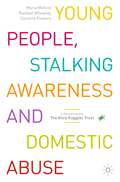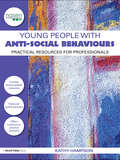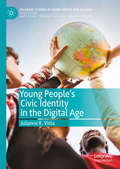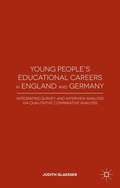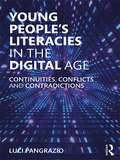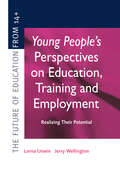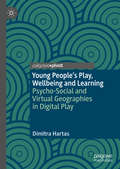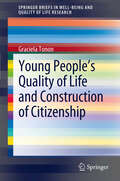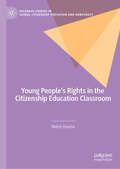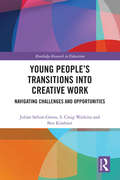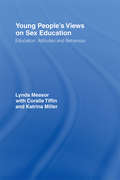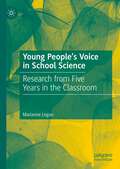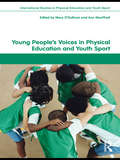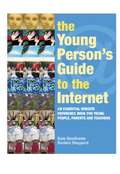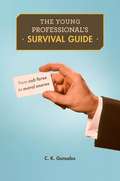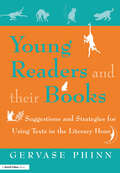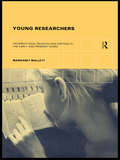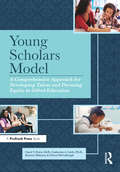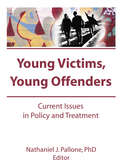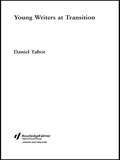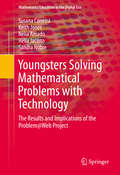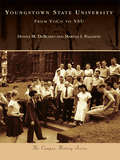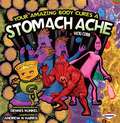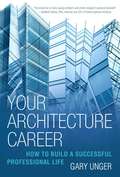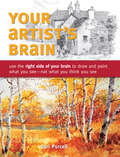- Table View
- List View
Young People, Stalking Awareness and Domestic Abuse
by Maria Mellins Rachael Wheatley Caroline FlowersThis book addresses domestic abuse and stalking among young people in the UK and Ireland, with a focus on intersectionality and lifestyle settings. In partnership with the Alice Ruggles Trust, this book draws on a wealth of expert contributions including those with lived experience, frontline services such as Paladin National Stalking Advocacy Service, charities EmilyTest and Hollie Gazzard Trust, researchers of so-called honour-based abuse and online harms, and forensic psychologists who work with people who stalk. It begins with an overview of ways to recognise harmful behaviours, including those carried out online. The discussion then moves on to methods and motivations of stalking and coercive control and the various lifestyle contexts including education environments, young people in the workplace, and the role of the police and frontline support services in tackling these issues. It is a vital resource for undergraduate students across criminology, sociology, law, psychology, education, social justice, policing, and forensic psychology, as well as a combination of academic researchers and professionals working within stalking and domestic abuse support and prevention. This action-orientated book also includes 'Key Points' and ‘Discussion Questions’ in each chapter to direct student learning in the classroom and to create discussion points for wider readers.
Young People with Anti-Social Behaviours: Practical Resources for Professionals (nasen spotlight)
by Kathy HampsonThe media today suggests that many young people are becoming involved in anti-social behaviour. But increasing amounts of legislation and ASBOs neither seem to have addressed the real issues nor solved the problem, and may simply add to the frustrations of all those involved. Kathy Hampson’s comprehensive guide is based on up-to-date, grass-roots experience of working with young people with anti-social behaviour. Including ready-to-use, photocopiable resources suitable for a wide variety of settings, it examines the background to these highly topical issues, enabling the reader to contextualise and better identify with the problems faced by the young people they work with. The easy-to-reproduce, tried-and-tested exercises: are for use with individuals or groups address the issues involved in offending behaviour can be easily modified to cater for a range of learning styles, abilities and maturity, (and shows how you can identify which exercises suit which young people) include discussion scenarios, worksheets, cartoons, card games and creative activities can be used to dissuade young people from getting involved in anti-social behaviour, and to enable them to make better decisions The book includes an appraisal of current research on the issues surrounding anti-social behaviour and, in particular, risk factors that may be involved ‘behind the scenes’ in young people’s lives. A section on working with parents helps them to support their children, improve their parenting skills and to know where, and how, to ask for help. This is an essential resource offering constructive, practical solutions to anti-social behaviour in young people between the ages of 10 and 18. It will be invaluable for those working professionally or voluntarily in schools, with youth groups, youth offending teams, youth inclusion projects, faith groups, anti-social behaviour teams, or for anyone whose work offers the opportunity, or requires them, to challenge anti-social and offending behaviour.
Young People's Civic Identity in the Digital Age (Palgrave Studies in Young People and Politics)
by Julianne K. ViolaThis book explores young people’s civic experiences in contemporary American society, and how they navigate the political world in an era defined by digital media. Drawing on the experiences of young people before they have reached voting age, the book provides vital perspectives on citizenship and civic engagement of a part of the population that is often overlooked. The author engages with the tensions young people encounter in their everyday personal and civic lives, particularly in their understanding and experience of civic identity in ways that are shaped by society’s (mis)perceptions of youth. The book introduces a new framework of civic identity that has been directly informed by the lived civic experiences of young people themselves. The findings will be of great interest to researchers and students working in political science, sociology, youth studies, education studies, and media studies, as well as policy-makers, practitioners, and parents of young people.
Young People’s Educational Careers in England and Germany
by Judith GlaesserThrough a comparative study of young people's educational careers in England and Germany, this book explores the range of influences which shape educational careers such as the individual talents and interests of young people, their social class and background, as well as school and country characteristics. Methodologically, the book develops a mixed methods approach that utilises Charles Ragin's increasingly popular Qualitative Comparative Analysis (QCA) to examine cross-case analyses of secondary survey data alongside within-case process-tracing analyses of interview data to establish causal understanding of educational careers. International comparison adds another dimension, exploiting the significant differences between the two countries' school and university systems. The book therefore offers both a contemporary account of young people's educational careers and decision-making as well as a practical contribution to ongoing debates concerning the establishment of causal andexplanatory knowledge in the non-experimental social sciences.
Young People's Literacies in the Digital Age: Continuities, Conflicts and Contradictions
by Luci PangrazioWhat do young people really do with digital media? Young People's Literacies in the Digital Age aims to debunk the common myths and assumptions that are associated with young people's relationship with digital media. In contrast to widespread notions of the empowered and enabled 'digital native', the book presents a more complex picture of young people's digital lives. Focusing on the notion of 'critical digital literacies' this book tackles a number of pressing questions that are often ignored in media hype and political panics over young people’s digital media use, including: In what ways can digital media enhance, shape or constrain identity representation and communication? How do digital experiences map onto young people’s everyday lives? What are young people’s critical understandings of digital media and how did they develop these? What are the dominant understandings young people have of digital media and in whose interests do they work? These questions are addressed through the findings of a year of fieldwork with groups of young people aged 14 to 19 years. Over the course of eight chapters, the experiences and views of these young people are explored with reference to various academic literatures, such as digital literacies, media and communication studies, critical theory and youth studies. Starting with their early socialisation into the digital context, the book traces the continuities, contradictions and conflicts they encounter as part of their practices. Written in a detailed but accessible manner, this book develops a unique perspective on young people’s digital lives.
Young People's Perspectives on Education, Training and Employment: Realising Their Potential (Future Of Education From 14+ Ser.)
by Jerry Wellington Lorna UnwinBased on interviews with over 150 young people in education and training, this volume reflects on their perspectives on the issues and challenges that education and training have to offer.
Young People's Play, Wellbeing and Learning: Psycho-Social and Virtual Geographies in Digital Play
by Dimitra HartasThis book explores the shifting geographies and contexts of children's play and learning. The author examines both free and guided play through the lenses of class, gender and disability, drawing links between face-to-face and online interactions. As young people increasingly spend time in virtual environments it is important to adjust understandings of how, and when, they engage with learning. The book examines play as a continuum of activities and peer interactions, interrogating what it takes to bridge the gap between academic and wellbeing goals for children with disabilities and disadvantage, as well as those at the intersection with other markers of difference (e.g. gender and race). It will be of interest and value to scholars of play and education, as well as those working with disabled or disadvantaged children.
Young People's Quality of Life and Construction of Citizenship
by Graciela TononThe study of quality of life refers to the material environment (social welfare) and psychosocial environment (wellbeing). It has been defined as a concept that implies the objective and subjective dimension that Cummins (1997) first studied in seven domains. The use of domains in the quality of life study allows a more precise measurement than the one that could have been reached through simple questions, since psychometric scales are used and if the addition of domains is equivalent to the totality of life satisfaction, then the group of domains is a valid measure of quality of life. In the case of young people, it has been observed that even if they live in negative physical, social and contextual conditions, they can nevertheless experience a relatively positive experience in relation to their quality of life, depending on the strategies and capabilities that they generate in relation to the context. Similarly, young people that live in favorable socioeconomic conditions and with a trouble free psychological situation may experience a relatively poor evaluation of their position in life (Patrick et al). oung people do not form a homogenous group and, in this sense, it is not possible to generalize about youth; they interact with the environment in which they live and they are a product of the history they happen to live, in this way they transit different vital scenarios in daily life that affect their quality of life. The social representations about youth that each population has, in each historical moment, are embedded in the social context in which young people live and develop, conditioning every-day life and /or creating related stereotypes. The concept of youth is a social construction built conjointly by all members of society in the historical moment in which they live. Young people interact with the environment in which they live and they are a product of the history they happen to live. Authors like Urresti (1999) define youth from a point of view that takes into account the living together of different generations in different societies, thus being impossible to compare young people of today with those of two or three decades ago; in addition, he states that it is necessary to situate the understanding of youth within the historical and social moment in which they live. Nowadays the predominant adult model is based in individualism, and even if an intergenerational dialogue is necessary, it is difficult for young people to achieve this kind of communication with adults that, in some cases, are living "stages of youth" or that need to be "forever young". Young people live in uncertainty, with a limited perspective for future action, assigning their own meaning to events and facts, according to their fundamental concerns that are significantly different from those of their parents' generation. In the other side the process of globalization and the protagonist social role of the new informational and communicational technologies, produce that the possibilities to expand individual freedoms increase, but not all young people can manage with it (Lechner, 2002). What young people need in order to construct their citizenship and feel satisfied, varies according to the different societies, especially considering that most of them live a fragile situation. As Cortina (2003:7-9) states, the idea of citizenship always transcends individualism, because the citizen is somebody that exists together with others, and those others are equal to him before the city, is somebody that deliberates with others, that acts with others conjointly, that assumes the protagonist role of his own life, in this way citizen is not only that who the law protects, but that who participates in the public issues. Speaking about young people we propose to recognize them from their equal dignity because "recognition is not only a courtesy that we owe others: it is an essential human need" (Taylor, 1993:46). This recognition is based in human dignity and tends to protect the basic rights of people as individuals and to recognize the particul...
Young People's Rights in the Citizenship Education Classroom (Palgrave Studies in Global Citizenship Education and Democracy)
by Helen HannaThis book explores the rights held by young people in the citizenship education classroom in the divided societies of Northern Ireland and Israel. Against the backdrop of a long history of protracted conflict and division, the author analyses how international rights obligations are reflected in the contested citizenship education curriculum in secondary schools. Drawing upon extensive qualitative data as well as policy and curriculum documents, the author reveals that understandings of education rights can be oriented around three themes – minority group representation in the curriculum, dealing with difference through pedagogy, and preparing young people for life in a (divided) society. This can be mapped onto the 42-A rights framework where education should be ‘acceptable’ and ‘adaptable’. However, the variety of interpretations held by participants raises questions regarding the ‘universality’ of international frameworks for education rights, and the workability of such frameworks in the national and divided contexts. While the contexts of Northern Ireland and Israel have much in common, they are rarely compared: this book will show that their comparison is as relevant as ever, as issues of identity continue to affect everyday school life. This book will be of interest to citizenship and history education scholars, as well as those who are concerned with the application of international human rights law.
Young People’s Transitions into Creative Work: Navigating Challenges and Opportunities (Routledge Research in Education)
by Julian Sefton-Green S Craig Watkins Ben KirshnerExploring how formal and informal education initiatives and training systems in the US, UK and Australia seek to achieve a socially diverse workforce, this insightful book offers a series of detailed case studies to reveal the initiative and ingenuity shown by today’s young people as they navigate entry into creative fields of work. Young People’s Journeys into Creative Work acknowledges the new and diverse challenges faced by today's youth as they look to enter employment. Chapters trace the rise of indie work, aspirational labour, economic precarity, and the disruptive effects of digital technologies, to illustrate the oinventive ways in which youth from varied socio-economic and cultural backgrounds enter into work in film, games production, music, and the visual arts. From hip-hop to new media arts, the text explores how opportunities for creative work have multiplied in recent years as digital technologies open new markets, new scenes, and new opportunities for entrepreneurs and innovation. This book will be of great interest to researchers, academics and postgraduate students in the fields of youth studies, careers guidance, media studies, vocational education and sociology of education.
Young People's Views on Sex Education: Education, Attitudes and Behaviour
by Dr Lynda Measor Lynda Measor Katrina Miller Coralie TiffinBased on observation of sex education programmes and in-depth interviews with young people, the authors aim to understand more about adolescent's attitudes to sexuality and their sexual behaviour in order to develop policies which will meet their needs more appropriately and effectively.Issues covered in this interesting and accessible book include the ways adolescent informal culture affects sex education programmes and practice; the impact of gender inequality on sex education and safer sex behaviours; legislation and policy frameworks which effect sex education policies; the way young people see legislation and evaluate sex education programmes; and the impact health professionals can have in school sex education.The authors contend that the insights into the values and views that young people bring to bear on the sex education they receive should have an important role to play in the development of policy and practice of those involved in sex education work.
Young People’s Voice in School Science: Research from Five Years in the Classroom
by Marianne LoganThis book highlights young people’s changing attitudes toward and interest in science over the course of a five-year longitudinal study. Utilizing a mixed-methods approach, the author presents rich data from children and young people, as well as their parents and teachers. By providing a glimpse of science pedagogy from the perspective of young people and those who work with them, the book identifies factors that affect students' interest in science throughout their primary and secondary education. The book also examines a posthumanist philosophical approach to science education and emphasizes the interrelationship of all things within the context of science education.
Young People's Voices in Physical Education and Youth Sport (Routledge Studies in Physical Education and Youth Sport)
by Mary O’SullivanHow do children and young people experience and understand sport and physical activity? What value do they attach to physical education and physical literacy? This important new book attempts to engage more directly than ever before with the experiences of young people by placing the voices of the young people themselves at the centre of the discussion. As the need to listen to young people becomes increasingly enshrined in public policy and political debate, this book illuminates our understanding of an important aspect of the everyday lives of many young people. With contributions from leading researchers and educationalists from around the world, the book draws on a diverse range of methodological and theoretical perspectives to demonstrate how we can better understand the unique perspectives of young people, how teachers and coaches can respond to and engage with the voices of young people, and how young people can be afforded opportunities to shape their education and leisure experiences. The book presents a fascinating range of case studies from around the world, including the experiences of African American girls and masculine sporting identities in Australia, and addresses both theoretical and policy debates. Young People’s Voices in Physical Education and Youth Sport is essential reading for any serious student or professional with an interest in PE, youth sport, sports development, sports coaching, physical activity and health, education or youth work.
The Young Person's Guide to the Internet: The Essential Website Reference Book for Young People, Parents and Teachers
by Kate Hawthorne Daniela SheppardIn this easy-to-use reference, over 1600 websites have been carefully researched and selected with educational and recreational needs in mind. Sorted into thirty categories including all National Curriculum subjects, the book provides brief descriptions of each website and the resources you can expect to find there. Some of the wide-ranging categories include art, attractions, careers and students, environment, film, TV and radio, reference and revision. The format is unique and simple, making this a perfect resource for young people, parents and teachers and an excellent support tool for schools and libraries.
The Young Professional’s Survival Guide: From Cab Fares To Moral Snares
by C. K. GunsalusA nationally recognized expert on professional ethics uses pungent real-world examples to help people new to the work world recognize ethical situations that can lead to career-damaging mistakes—and prevent them. Gunsalus offers questions to ask yourself, sample scripts to use on others, and guidance in handling disputes fairly and diplomatically.
Young Readers and Their Books: Suggestions and Strategies for Using Texts in the Literacy Hour
by Gervase PhinnFirst Published in 2000. Routledge is an imprint of Taylor & Francis, an informa company.
Young Researchers: Informational Reading and Writing in the Early and Primary Years
by Margaret MallettInformational kinds of reading are crucial in every lesson. This book looks at how we can encourage children from the very beginning to think of themselves as young researchers using skills and strategies for clear purposes. It argues that the creative practitioner nurtures children's sense of wonder and curiosity about the world and all its phenomena.Packed full of advice on how to use the most stimulating and exciting texts and the liveliest approaches, the book celebrates the good practice of teachers and student teachers in a large number of classroom case studies.The content includes:* a summary of the recent developments and a framework of principles to inform good practice in this challenging aspect of literacy* chapters concentrating on particular age groups - beginning with the nursery and ending with the later primary years - and thus taking up an essentially developmental approach* an assessment of recent research and how findings can be put to practical and creative use in the classroom.A central message is that children benefit from collaborating with teachers and peers at every stage of finding out. The spoken language energises informational reading and writing, making the sharing of the fruits of children's research highly enjoyable. This book will inspire you and lead to the very best practice.
Young Scholars Model: A Comprehensive Approach for Developing Talent and Pursuing Equity in Gifted Education
by Carol V. Horn Catherine A. Little Kirsten Maloney Cheryl McCulloughHistorically, students from ethnically, linguistically, and economically diverse backgrounds have been overlooked and underidentified for gifted services. The Young Scholars Model is a comprehensive approach to addressing the issue of underrepresentation through engagement of a schoolwide effort and commitment. This book:Shares how the model leads to increased representation in identification and student success in advanced academic programs.Describes the four major components of the model and how they integrate in practice.Supports efforts to find and nurture potential in students who have historically been overlooked for gifted services.Includes steps for implementation and practical guidelines that schools and districts will be able to follow with fidelity and success.
Young Victims, Young Offenders: Current Issues in Policy and Treatment
by Letitia C PalloneAt a time when the nation is focused on devising new responses to street crime and on reforming the juvenile justice system, this book brings together in a single volume, current and emerging perspectives on the control of crime by and against children and youth. Young Victims, Young Offenders provides you with an overview of established and emerging practices in treating juvenile offenders and adults who prey on children and youth.This book explores the nature and causes of criminal offenses committed by and against juveniles. While children and youth show up statistically as offenders, they also figure disproportionately as victims. The contributing authors consider both of these aspects as they discuss current programs for the treatment of youths who commit or are victimized by criminal offenses.Topics of a wide range are addressed in Young Victims, Young Offenders for people--like you-- who work with our nation’s youth. A sampling of topics includes: How states address child maltreatment through reporting laws and special courtroom procedures Associations between selected psychosocial variables and chronic delinquency Implications of mandatory Child Abuse Reporting Laws on treating offenders The success of diversion during a 20-year period in a youth service bureau Clinical techniques in the treatment of juvenile sex offenders A study on the effectiveness of an intervention program in Iowa for youthful offendersThis book is useful for the pre-service student pursuing course work in juvenile delinquency, correctional counseling, probation, parole, and social work. At the in-service level, correctional counselors, probation officers, parole officers, social workers, psychologists, psychiatrists, correctional administrators, and child care workers can find much to challenge and enhance their effectiveness in their work with young victims and offenders.
Young Writers at Transition (Language and Literacy in Action)
by Daniel TaborHow does children's writing develop in the transition from primary to secondary school? Young Writers at Transition tracks a group of pupils from the end of Year 6 into the first half of Year 7. It analyses in detail the teaching and uses of writing at this important stage in their education, and uncovers some revealing findings concerning the experiences, perceptions and expectations of pupils, teachers and parents about writing.The authors link their findings to the broader issues of policy and our understanding about how writing is taught and used in transition. This timely book examines issues such as: * transition, continuity and progression, and how these can be managed to ensure standards do not suffer* the variety of teaching and uses of writing in Years 6 and 7* secondary school teachers' views of writing, and what practice is most effective for them* different ways of thinking about transition, continuity and progression* how the National Literacy Strategy has affected continuity and progression in children's writing at transition. This interesting study of the uses of writing will be a valuable resource, with practical suggestions, to teachers and educators in primary and secondary schools.
Youngsters Solving Mathematical Problems with Technology
by Susana Carreira Keith Jones Nélia Amado Hélia Jacinto Sandra NobreThis book contributes to both mathematical problem solving and the communication of mathematics by students, and the role of personal and home technologies in learning beyond school. It does this by reporting on major results and implications of the Problem@Web project that investigated youngsters' mathematical problem solving and, in particular, their use of digital technologies in tackling, and communicating the results of their problem solving, in environments beyond school. The book has two focuses: Mathematical problem solving skills and strategies, forms of representing and expressing mathematical thinking, technological-based solutions; and students´ and teachers´ perspectives on mathematics learning, especially school compared to beyond-school mathematics.
Youngstown State University: From YoCo To YSU
by Donna M. Deblasio Martha I. PallanteAs Youngstown State University prepares to celebrate its centennial anniversary in 2008, this book is a reflection on its history and heritage. Starting as a YMCA law school in 1908, the institution that became Youngstown State University is now a major and vital force in the community and the region. The images collected here illustrate the transformation of the institution from a storefront operation in the downtown area, to classroom space in former mansions, to a full-blown 21st-century campus. As the community itself became more diverse, the institution that it spawned followed suit as did its student body, faculty, staff, and programs.
Your Amazing Body Cures a Stomach Ache
by Vicki CobbMeet your personal superheroes - your body's cells! Superhero cells rally together to battle common childhood ailments in this series in which Vicki Cobb explains how your amazing human body heals itself and fights off intruders.
Your Architecture Career: How to Build a Successful Professional Life
by Gary UngerMaster the business side of architecture with advice from an expert. In Your Architecture Career, Gary Unger provides tips and guidance to students, interns, architects, and firm owners to help them understand and master the business side of architecture and interior design. Students in school are not taught to manage process, projects, and clients—the emphasis is on design. However, most graduates will not finish their careers as designers. Rather, their focus will be on marketing, programming, project management, cost estimating, rendering, virtual reality, drawing documentation, specifications, workplace strategy, and construction administration. Gary Unger expertly describes the creative aspects of these disciplines and the considerable value they bring to a firm. In order to accurately represent how an architecture firm successfully operates, Gary stresses the importance of teamwork. With project teams made up of architects, engineers, realtors, building owners, contractors, furniture dealers, and more, it is important to note that a project's success is measured by how well handoffs of information are executed both inside a firm as well as from firm to firm. Spanning a wide variety of topics, chapters include: Completing architectural school Deciding on a career path Landing your first job Building your reputation Managing handoffs RFPs and proposals Reassessing your career Starting your own firm Whether you're a student about to graduate or a seasoned professional, Your Architecture Career is an invaluable resource for the business side of architecture.
Your Artist's Brain: Use the right side of your brain to draw and paint what you see - not what you t hink you see
by Carl PurcellOvercome the obstacles to your artistic expressionImproving your artwork can be as simple as learning how to trust your eyes. Your Artist's Brain shows you how to portray even the most complex subjects by focusing on what you really see - not what you think you see.Expert art instructor Carl Purcell shows you how to overcome dependency on the "intellectual brain" and listen carefully to the more observant "artist's brain."With Your Artist's Brain, you'll learn visual skills and artistic techniques that will instantly make you a better artist, no matter what your medium.22 step-by-step demonstrations on key relationships between shapes, spaces, subjects, backgrounds, angles, sizes, values and moreEasy examples and fun exercises teaching you how to "see" and design great compositions "Points to Remember" sidebars that allow you to quickly grasp each conceptMaximize the power of your artist's brain today and embark on the path to creating better art.
